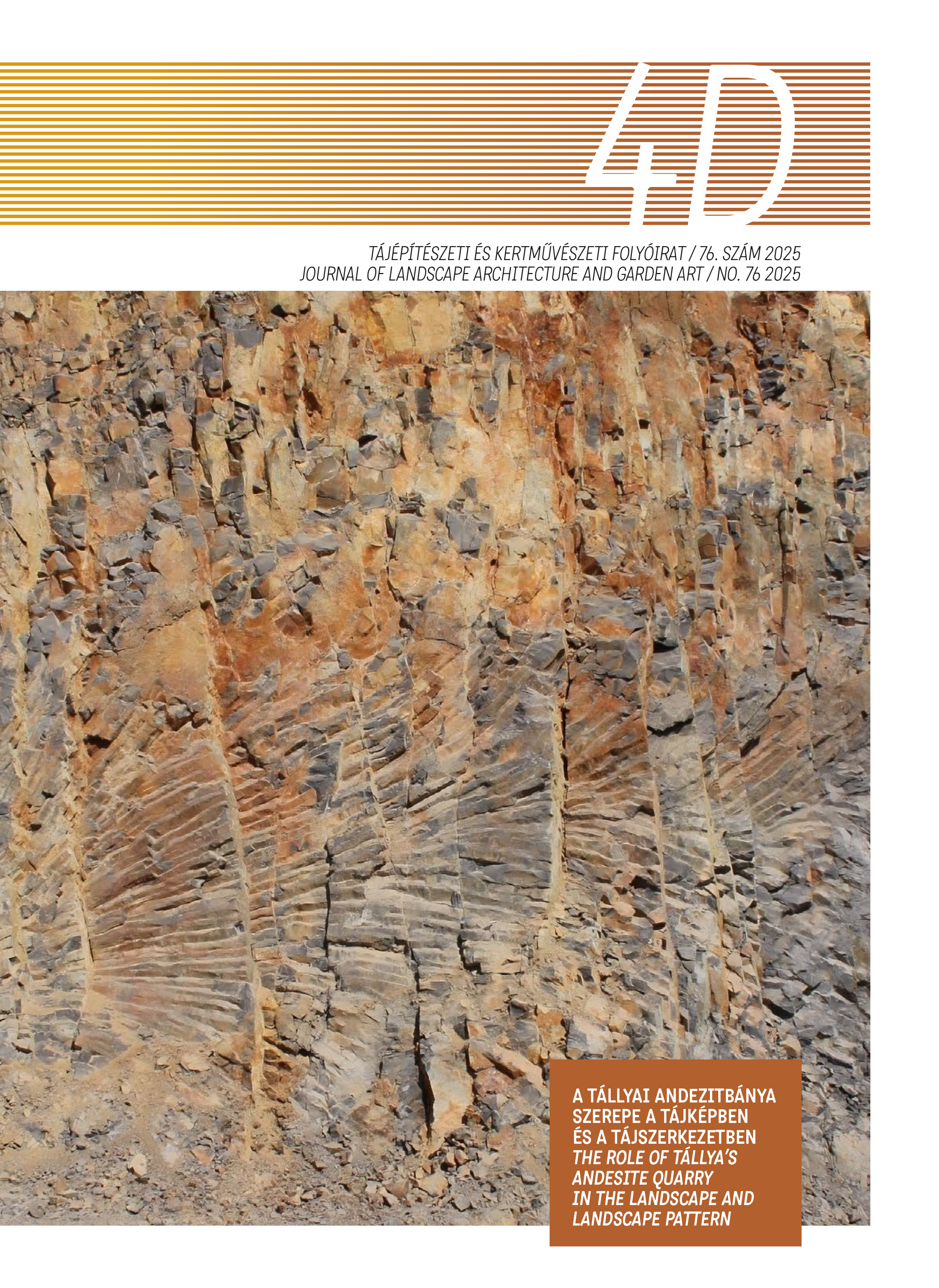2D-ből 3D-be
A városi zöldterületek vizualizációs és elemzési módszereinek áttekintése különböző léptékekben
DOI:
https://doi.org/10.36249/4d.76.6375Kulcsszavak:
városi zöldfelület, tájodellezés, 3D vegetációs térfogatAbsztrakt
A városi információs modellezés, valamint az intelligensvárosok fejlődésével a hagyományos 2D-alapú városterve-zési folyamat napjainkban 3D-s panorámás, térbeli terve-zéssé alakul át. A jelenlegi városi zöldterületek modelle-zési és elemzési módszerei nagyrészt 2D-s tájmintákra ésmutatókra támaszkodnak, amelyek nem képesek kifejeznia zöldterületek vertikális jellemzőit. Jelen tanulmány átte-kinti a zöldterületek 3D környezetben történő modellezé-sére általánosan használt módszereket, és elemzi alkal-mazhatóságukat. Három különböző léptékű – térségi, tele-pülési és objektum szintű - esettanulmányt tárgyal, majdmélytanuláson és parametrikus modellezési eszközökönalapuló automatizált modellezési és elemzési eljárást építfel mindegyikhez. A három esettanulmány a következőmódszereket veszi sorra: országos léptékű 3D vegetációstérfogat becslése a GEDI segítségével Kína különbözővárosaira, voxel-modellek építése LiDAR pontfelhőadatokalapján egy középiskolai campus zöldfelületeire, vala-mint L-rendszer generatív algoritmusok alkalmazása a fáknövekedésének szimulálására és előrejelzésére egy kol-légiumi területen. A javasolt 3D zöldterületi modellezésiés elemzési módszerek támogathatják a zöldterületek észöldfelületek 3D modellezési és elemzési igényeit külön-böző léptékekben.
Hivatkozások
[1] Casalegno, Stefano – Anderson, Karen – Cox, Daniel T. C. – Hancock, Steven – Gaston, Kevin J (2017). Ecological connectivity in the three-dimensional urban green volume using waveform airborne lidar. Scientific Reports, 7, 45571. DOI: https://doi.org/10.1038/srep45571
[2] Kazazi, Ali Khosravi – Rabiei-Dastjerdi, Hamidreza – McArdle, Gavin (2022): Emerging paradigm shift in urban indicators: Integration of the vertical dimension. Journal of Environmental Management, 316, 115234. p. 12 DOI: https://doi.org/10.1016/j.jenvman.2022.115234
[3] Shu, Qiguan – Roetzer, Thomas – Detter, Andreas – Ludwig, Ferdinand (2022): Tree Information Modeling: A Data Exchange Platform for Tree Design and Management. Forests, 13(11), 1955. DOI: https://doi.org/10.3390/f13111955
[4] Gobeawan L. – Lin, E. S. – Tandon, A. – Yee, A. T. K. – Khoo, V. H. S. – Teo, S. N. – Yi, S – Lim, CW – Wong, ST – Wise, DJ – Cheng, P – Liew, S. C. – Huang, X – Li, Q. H. – Teo, L. S. – Fekete, G. S. – Poto, M. T. (2018): Modeling trees for virtual Singapore: From data acquisition to CityGML models. The International Archives of the Photogrammetry. Remote Sensing and Spatial Information Sciences, 42, 55-62. DOI: https://doi.org/10.5194/isprs-archives-XLII-4-W10-55-2018
[5] Rappaport, Danielle I. – Morton, Douglas C. – Longo, Marcos – Keller, Michael – Dubayah, Ralph – dos-Santos, Maiza Nara (2018): Quantifying long-term changes in carbon stocks and forest structure from Amazon forest degradation. Environmental Research Letters, 13(6), 065013. DOI: https://doi.org/10.1088/1748-9326/aac331
[6] Hosoi, Fumiki – Nakai, Yohei – Omasa, Kenji (2013): 3-D voxel-based solid modeling of a broad-leaved tree for accurate volume estimation using portable scanning lidar. ISPRS Journal of Photogrammetry and Remote Sensing, 82, 41–48. DOI: https://doi.org/10.1016/j.isprsjprs.2013.04.011
[7] Li, Shihua – Dai, Leiyu – Wang, Hongshu – Wang, Yong – He, Ze – Lin, Sen (2017): Estimating Leaf Area Density of Individual Trees Using the Point Cloud Segmentation of Terrestrial LiDAR Data and a Voxel-Based Model. Remote Sensing, 9(11), 1202. DOI: https://doi.org/10.3390/rs9111202
[8] Omasa, Kenji – Hosoi, Fumiki – Uenishi, T. M. – Shimizu, Yoshikazu – Akiyama, Yukihide (2008): Three-Dimensional Modeling of an Urban Park and Trees by Combined Airborne and Portable On-Ground Scanning LIDAR Remote Sensing. Environmental Modeling & Assessment, 13(4), 473–481. DOI: https://doi.org/10.1007/s10666-007-9115-5
[9] Anderson, Karen – Hancock, Steven– Casalegno, Stefano– Griffiths, Amber – Griffiths, David– Sargent, F. – McCallum, John– Cox, Daniel T. C. – Gaston, Kevin J. (2018): Visualising the urban green volume: Exploring LiDAR voxels with tangible technologies and virtual models. Landscape and Urban Planning, 178, 248–260. DOI: https://doi.org/10.1016/j.landurbplan.2018.05.024
[10] Lindenmayer, Aristid (1968): Mathematical models for cellular interactions in development, Parts I and II. Journal of theoretical biology, 18(3), 280-315. DOI: https://doi.org/10.1016/0022-5193(68)90079-9
[11] Huo, Kedi (2021): Research on Tree Branch Modeling Methods of L-system Based on Image Sequence. [Master thesis]. Nanjing Normal University: Nanjing. DOI: https://doi.org/10.27245/d.cnki.gnjsu.2020.000701
[12] Liu , Pu – Liu, Yuan – Xu, Xiaosheng (2016): Three-Dimensional Modeling Technology of Virtual Plant in Digital Landscape. In: Shanmugapriya – B., Sengar – J.S., Weller – K. (ed.) 2016 International Conference on Communications, Information Management and Network Security, Shanghai, China, SEP 25-26, 2016, Atlantis Press: Paris, France, 146-149.
[13] Hamon, Ludovic – Richard, Emmanuelle – Richard, Paul – Boumaza, Rachid – Ferrier, Jean-Louis (2012): RTIL-system: A Real-Time Interactive L-system for 3D interactions with virtual plants. Virtual Reality, 16(2), 151–160. DOI: https://doi.org/10.1007/s10055-011-0193-y
[14] Mech, Radomír (1997): Modeling and simulation of the interaction of plants with the environment using L-systems and their extensions. [PhD thesis]. University of Calgary, Calgary.
[15] Tanveer, M. Hassan – Thomas, Antony – Wu, Xiaowei – Zhu, Hongxiao (2020): Simulate Forest Trees by Integrating L-system and 3D CAD Files. In: O’Conner – Lisa (ed.) 2020 3rd International Conference on Information and Computer Technologies (ICICT), San Jose, USA, MAR 09-12, 2020, IEEE Computer Society: Los Alamitos, USA, 91–95. DOI: https://doi.org/10.1109/ICICT50521.2020.00022
[16] Ministry of Housing and Urban-Rural Development of the People's Republic of China (2018): Standard for classification of urban green space (26.06.2018). URL: https://www.mohurd.gov.cn/gongkai/zc/wjk/art/2018/art_17339_236545.html [21.04.2025]
[17] Lang, Nico – Jetz, Walter – Schindler, Konrad – Wegner, Jan Dirk (2023): A high-resolution canopy height model of the Earth (15.02.2023). URL: https://langnico.github.io/globalcanopyheight/ [31.10.2024]
[18] ESRI (2022): Point cloud classification using PointCNN (2022) URL: https://developers.arcgis.com/python/guide/point-cloud-segmentation-using-pointcnn/ [31.10.2024]
[19] The USDA Forest Service (2022): i-Tree Database (01.06.2022). URL: https://database.itreetools.org/#/species [31.10.2024]
Letöltések
Megjelent
Folyóirat szám
Rovat
License
Copyright (c) 2025 Wei Zhang, Anqi Chen, Valánszki István

This work is licensed under a Creative Commons Attribution-NonCommercial-NoDerivatives 4.0 International License.
A folyóirat Open Access (Gold). Cikkeire a Creative Commons 4.0 standard licenc alábbi típusa vonatkozik: CC-BY-NC-ND-4.0. Ennek értelmében a mű szabadon másolható, terjeszthető, bemutatható és előadható, azonban nem használható fel kereskedelmi célokra (NC), továbbá nem módosítható és nem készíthető belőle átdolgozás, származékos mű (ND). A licenc alapján a szerző vagy a jogosult által meghatározott módon fel kell tüntetni a szerző nevét és a szerzői mű címét (BY).









 intézetigazgató: Dr. Fekete Albert
intézetigazgató: Dr. Fekete Albert

